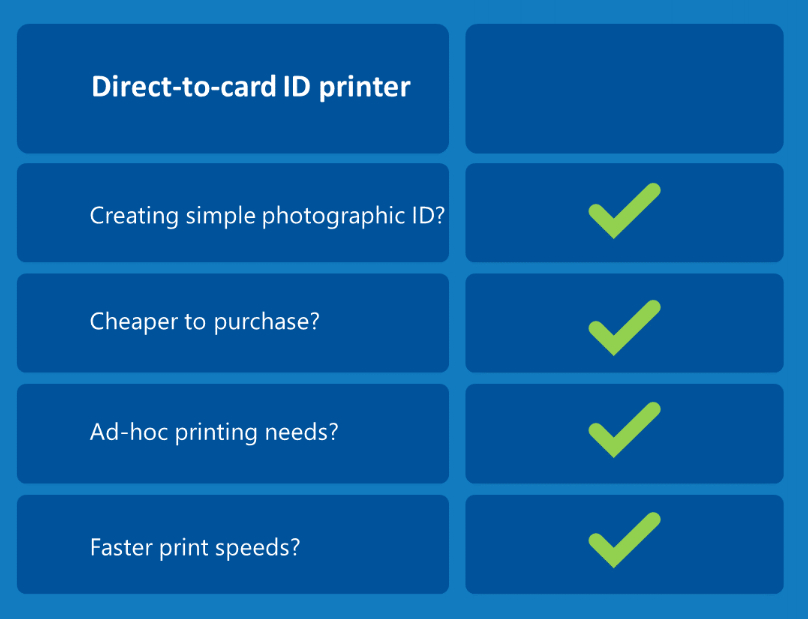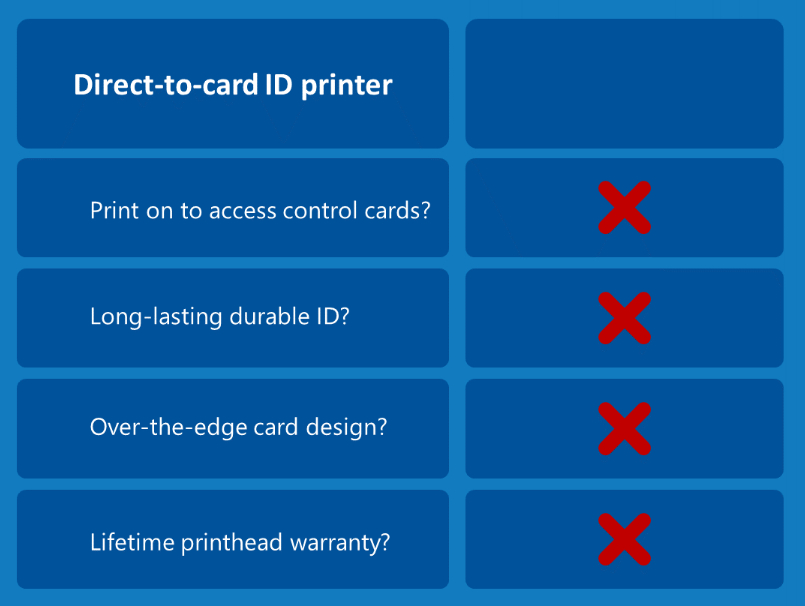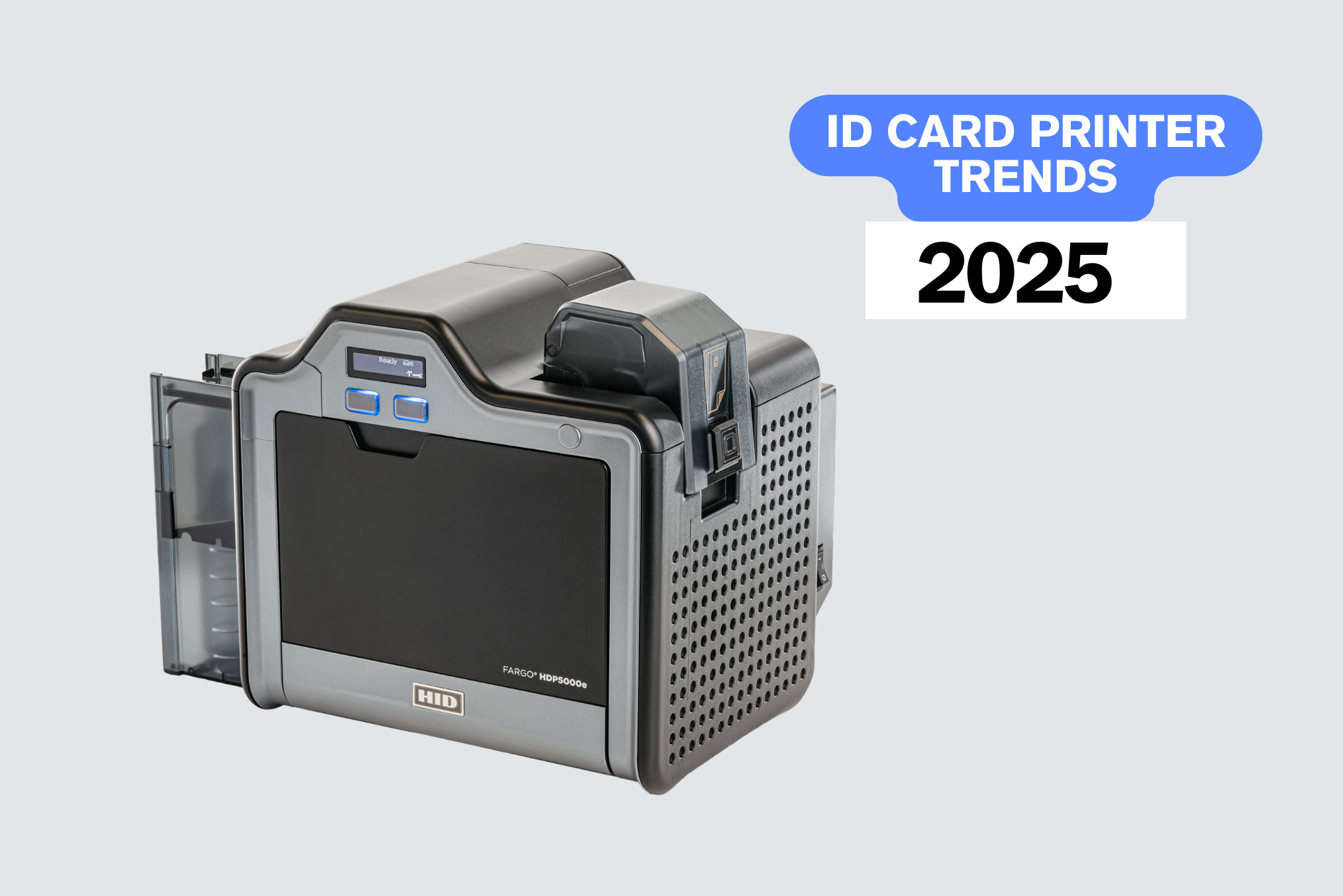Choosing an ID card printer can be difficult, particularly if you’ve never purchased one before. Despite the huge amount on offer, they use one of two main types of technology: direct-to-card (aka DTC) or retransfer (aka reverse transfer).
In this guide, we’ll be talking about direct-to-card printers. We’ll talk you through how they work, how they compare to retransfer printers, their benefits and limitations, as well as consider who they are best suited for.
1. What is a direct-to-card printer?
A direct-to-card printer is a printer that prints ink directly onto an ID card surface. Compared to retransfer printers, direct-to-card printing is an older technology that has some limitations if you’re looking to create a secure photographic ID card. That said, they are often the best ID card printer for small businesses with low- to medium-volume requirements that need simple photographic identification.
To understand the difference between a DTC and retransfer ID card printer, check out our retransfer printer guide here.
2. How does a direct-to-card printer work?

The technology in a direct-to-card printer is surprisingly similar to regular inkjet printers. This is because a printhead passes over the card inside the printer and deposits ink directly onto the surface of the card itself. Instead of ink cartridges, an ID card printer ribbon contains the ink used to print. This printer ribbon passes between two spools in the printer and, when it comes into contact with the thermal printhead, the card design will be printed onto the card. This is a printing process called dye sublimation, which explains why you may hear direct-to-card printers referred to as dye-sub printers.
Dye-sublimation printing is achieved by creating a “diffusion” process. In layman’s terms, that essentially means that the colours are melded together by the thermal printhead. DTC ID card printers are capable of producing more than 16.7 million colours, and most will print either 300 or 600 dots per inch (DPI). While they don’t offer the same quality print that a retransfer ID card printer would, they are more than capable of producing crisp, clear, full colour printed cards and photo ID.
3. What are the benefits of a direct-to-card printer?

Despite being an older, less sophisticated print technology than retransfer, direct-to-card printers remain the most popular type overall. Here are some of the reasons why.
Price
Direct-to-card ID card printers are the more affordable option, owing to their older technology. DTC printers can cost anywhere from £500 for a handfed basic model, rising to £1,000+ for more sophisticated machines capable of high-volume printing. You won’t be spending as much on consumables like printer ribbons either, due to the fact direct-to-card printers don’t use a retransfer film.
You can read more about our best entry-level ID card printers suited to new and smaller businesses here.
Speed
Direct-to-card printers produce ID cards faster than retransfer printers so, they’re suited to those with higher print volume requirements. Most high-volume direct-to-card printers allow you to produce a single-sided colour card in less than 20 seconds. The same printer can produce a single-sided monochrome card in just six seconds, while a full-colour dual-sided card will take around 24 seconds.
The IDP range of DTC ID card printers are designed for high-speed printing without compromising on quality, you can compare the IDP Smart 21, 31 & 51 here and read more about the benefits of this printer technology.
4. What are the limitations of a direct-to-card printer?

Despite their plus points, direct-to-card printers do have their limitations compared to the more advanced reverse transfer technology.
Access control
It isn’t advised to use a direct-to-card machine to print onto access control cards. These smart cards have raised ridges around their internal technology. Because the printhead on a DTC printer comes into contact with the card surface, these ridges can cause damage to the printhead leading to costly repairs and less consistent print quality.
Print Quality
Direct-to-card printers are not capable of over-the-edge printing – this means there will always be a thin white border around the edge of the card. This is fine if you only plan on printing simple membership cards, photo ID cards or logos onto blank cards. If you have intricate card designs and want a more professional finish, you’d be better off looking into a retransfer ID card printer.
Card life
Cards printed by a direct-to-card printer are not automatically as durable as those created using a retransfer ID card printer. This is because you will need to print using a ribbon fitted with a protective overlay film. Otherwise, the result is a card that will not last as long and will be more prone to fading over time. As workplaces reopen in 2022, and ID card surfaces are wiped down using cleaning products, this can cause issues. The picture below demonstrates the problem.

The lower card has been printed using a direct-to-card printer without an overlay ribbon panel, and the top by a retransfer printer. Both were exposed to the same amount of hand sanitiser over the same period of time. Can you see the difference?
Wear and tear
Due to their sensitive printheads, Direct-to-card printers are more likely to suffer wear and tear problems down the line. This is because the printhead comes into direct contact with the card and over time, this causes wear and tear.
Most manufacturers only offer a two or three-year warranty on the printhead of a DTC ID card printer. Retransfer printers, on the other hand, usually benefit from a lifetime printhead warranty.
5. What printer options can be added to a direct-to-card printer?
Exact plastic card printer options will vary depending on the model in question, but below we run through some of the most important add-ons that you may wish to think about when buying an ID card printer.
Dual-sided printing module
A dual-sided printer is a great option if you want to print on both sides of the card. It’s particularly useful if you have a lot of information to print – allowing you to split it over two sides of ID cards, ensuring an uncluttered and professional look. The reverse of a card can also contain information such as ID policies, QR codes, barcodes or emergency information.
Technically you can create a dual-sided card with a single-sided printer. However, having to print on the back of a batch of ID cards that have already been printed on is not only time consuming, but introduces the risk of contaminating the printhead with dirt and debris. This can cause damage to the printhead and affect the quality of printed cards.
Currently, the Magicard 300 features a free upgrade to dual-sided printing.
Encoding modules
We highly advise avoiding printing directly onto access control cards with a direct-to-card printer, but it is possible to encode smart cards with the addition of a module. The type of encoders available will vary between printers, but upgrading modules for magnetic stripe encoding and access control and proximity cards are usually available. The latter means they are the perfect option for encoding HID’s iCLASS, MIFARE Classic and MIFARE DESFire among contactless smart cards.
6. Who are direct-to-card printers best for?
DTC ID card printers remain the best choice for those looking to create highly cost-effective photographic identification. We’d always advise smaller businesses with ad-hoc printing needs should opt for this type of ID card printer, but they can also work in larger-scale environments such as schools and colleges too.
Direct-to-card printers aren’t designed for those looking to print onto access control cards. If you’re looking for long-lasting identification, a retransfer printer is probably the better bet.
For lots of businesses and organisations though, direct-to-card machines still work just fine and are more cost-efficient ID card printers. With high print speed and lower cost printer ribbon, DTC ID card printers are ideal for use in offices requiring faster turnaround times for producing good quality ID cards.
Direct-to-card vs retransfer: Need help choosing?
There are pros and cons to both Direct-to-Card and Retransfer ID card printers, and you can browse our full list of best selling ID card printers here.
If you’re unsure about which type of printer technology is best for you and your business, you can get in touch with our printer experts directly on 0800 988 2095.



